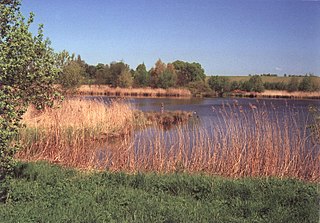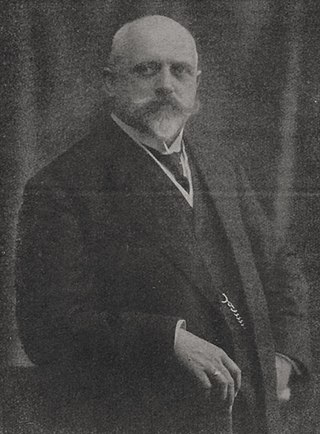
Schloss Ettersburg is a palace with its extended park near Weimar, Thuringia, Germany. It sits on the Ettersberg. From 1998 it has been part of the ensemble Klassisches Weimar, a World Heritage Site.

Schloss Ettersburg is a palace with its extended park near Weimar, Thuringia, Germany. It sits on the Ettersberg. From 1998 it has been part of the ensemble Klassisches Weimar, a World Heritage Site.
Schloss Ettersburg was built by Duke Wilhelm Ernst of Saxe-Weimar who liked to hunt in the forests on the Ettersberg, a mountain range of 474 metres (1,555 ft) north of Weimar. The first building was erected between 1706 and 1712 as a simple structure of three wings. The so-called Neues Schloss (New palace) was added in 1722. His nephew, Duke Ernest Augustus, transformed the palace, also adding an outside staircase in the south, between 1728 and 1740. The history of the building and its original furnishings can hardly be traced as the documents were destroyed by fire. [1]
When Karl August was Duke, his mother Anna Amalia used the palace as a summer residence from 1776 to 1780. She held a literary circle of authors such as Wieland, Goethe, Herder, Johann Karl August Musäus, and the actress Corona Schröter. It was also home to the Weimar Liebhabertheater lay theatre.Friedrich Schiller completed his play Maria Stuart there in 1800.
Schloss Ettersburg is one of the most complex hunting resorts of Thuringia. [2]


A substantial restoration began in 2006, supported by a 1990 association Kuratorium Schloss Ettersburg.
Schloss Ettersburg was transformed into a hotel with restaurant and venue for education. It is used mostly by the Bauhaus Akademie Schloss Ettersburg, founded in 2008 as an academy for architects, engineers and other professionals around building. It is also a venue for cultural events such as the Pfingst.Festival Schloss Ettersburg that has offered two weeks of classical, jazz and pop concerts, concerts with recitation, theatre and Ettersburger Gespräche talks, founded in 2011.
The ensemble of palace and park was awarded the 2009 Nationaler Preis für integrierte Stadtentwicklung und Baukultur by the Federal Ministry for Digital and Transport.

Weimar is a city in the state of Thuringia, Germany. It is located in Central Germany between Erfurt in the west and Jena in the east, approximately 80 km (50 mi) southwest of Leipzig, 170 km (106 mi) north of Nuremberg and 170 km (106 mi) west of Dresden. Together with the neighbouring cities of Erfurt and Jena, it forms the central metropolitan area of Thuringia, with approximately 500,000 inhabitants. The city itself has a population of 65,000. Weimar is well-known because of its large cultural heritage and its importance in German history.

Schloss Altenstein is a schloss, or palace, upon a rocky hill on the south-western slope of the Thuringian Forest, not far from Eisenach, Thuringia, Germany. It was the summer residence of the Dukes of Saxe-Meiningen, and is surrounded by 160 hectares of English landscape garden, which contain, among other objects of interest, a cavern 300 metres long, through which flows a large and rapid stream.

Reinhardsbrunn in Friedrichroda near Gotha, in the German state of Thuringia, is the site of a formerly prominent Benedictine abbey, the house monastery of the Ludovingian Landgraves of Thuringia abbey extant between 1085 and 1525. Later used as an administrative seat by the Ernestine dukes of Saxony, the property was turned into a castle and park erected by the Dukes of Saxe-Coburg and Gotha from 1827.

Wilhelm, Duke of Saxe-Weimar, was a duke of Saxe-Weimar.

The Ludovingians or Ludowingians were the ruling dynasty of Thuringia and Hesse during the 11th to 13th centuries.

A Jagdschloss is a hunting lodge in German-speaking countries. It is a schloss set in a wildlife park or a hunting area that served primarily as accommodation for a ruler or aristocrat and his entourage while hunting in the area.

The Stiftung Ettersberg is legally established foundation, located in Weimar, Germany. Its mission is the comparative study of European dictatorships and their transition to democracy. The foundation administers the Memorial and Education Centre Andreasstrasse, a museum housed in the former Stasi prison in Erfurt.

The Weimar–Gera railway is a line in the German state of Thuringia, connecting the city of Weimar via Jena, Stadtroda and Hermsdorf to Gera. It was built by the Weimar-Gera Railway Company, which was founded in June 1872, and the line was officially accepted into operation in June 1876.

Ludwig II, Landgrave of Thuringia, nicknamed Louis the Iron.

Schloss Weimar is a Schloss (palace) in Weimar, Thuringia, Germany. It is now called Stadtschloss to distinguish it from other palaces in and around Weimar. It was the residence of the dukes of Saxe-Weimar and Eisenach, and has also been called Residenzschloss. Names in English include Palace at Weimar, Grand Ducal Palace, City Palace and City Castle. The building is located at the north end of the town's park along the Ilm river, Park an der Ilm. It forms part of the World Heritage Site "Classical Weimar", along with other sites associated with Weimar's importance as a cultural hub during the late 18th and 19th centuries.

The Opfermoor Vogtei is an open-air museum at the location of a prehistoric and protohistoric sacrificial bog in the municipality of Vogtei, Thuringia, in Germany. It lies within the former municipality of Oberdorla, approximately 200 metres (220 yd) from Niederdorla, and the site is also known by those names.

Nikolaus Gromann was an architect of the German Renaissance who served at the court of John Frederick I, Elector of Saxony. He also worked for John Frederick's descendants residing in the cities of Weimar, Gotha and Altenburg, thus spending more than 30 years in the service of the House of Wettin.

The Free State of Coburg emerged from the Duchy of Saxe-Coburg and Gotha at the end of the First World War. It existed from November 1918 until its union with the Free State of Bavaria on 1 July 1920.

Schloss Muskau is a schloss in the Görlitz district in the state of Saxony, Germany. It is located in an extended park, the Muskau Park, since July 2004 a UNESCO World Heritage Site. The building complex was developed over a long period. The present main building, called Neues Schloss, was built in the 19th century in Neo-Renaissance style, burnt down in 1945, and after decades as a ruin, was reconstructed until 2013.

Schloss Seehof is a Schloss (palace) in Memmelsdorf, Bamberg, Germany. It was built from 1684 to 1695 as a summer residence and hunting lodge for Marquard Sebastian Schenk von Stauffenberg, Prince-bishop of Bamberg.

The Weimar courtyard of the muses is a term, that had emerged during the 19th century. It refers to an elite fellowship of people in Classical Weimar (1772-1805), that was made up of nobles and commoners, courtiers, civil servants, writers, artists and scientists, who congregated around the central character, Duchess Anna Amalia of Saxe-Weimar-Eisenach, pioneer of Weimar Classicism and patroness of the arts. Duchess Anna Amalia was the mother and from 1758 until 1775 regent for the infant Grand Duke Karl August von Sachsen-Weimar-Eisenach. Among the poets living in Weimar were the most famous German authors of their time, Johann Wolfgang von Goethe, Friedrich Schiller, Christoph Martin Wieland and Johann Gottfried Herder.
Heinrich Andreas Contius, also Cuntius is considered the most important organ builder in the Baltic States in the 18th century.

Gustav Wendling was a German history, landscape and marine painter; associated with the Düsseldorfer Malerschule.

Theodor Groll, also Theodor Groll the younger was a German genre, landscape and architect painter of the Düsseldorf school of painting.